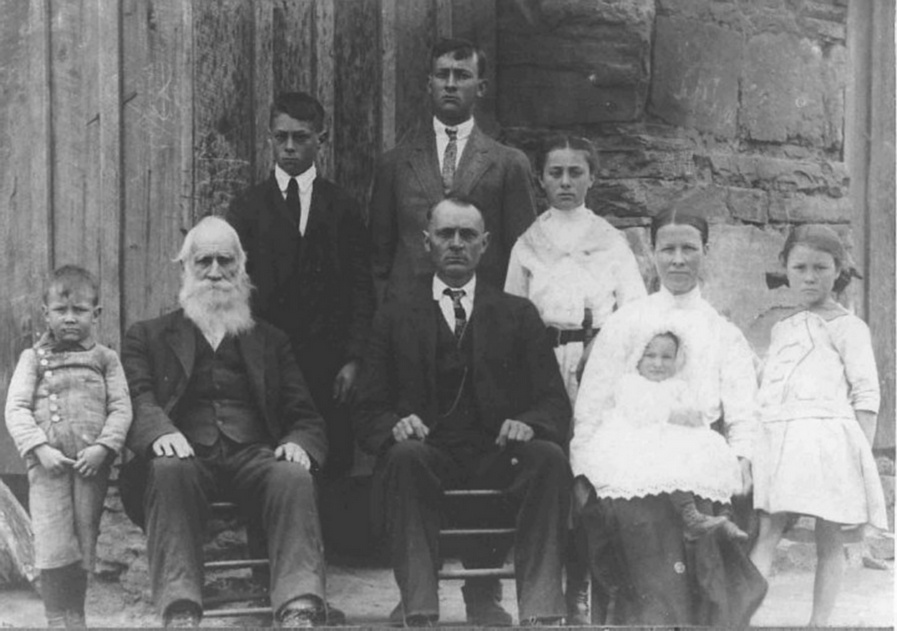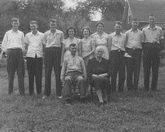|
John C. Inscoe, Mountain Masters, Slavery, and the Sectional Crisis in Western North
Carolina . Knoxville: Univ. of Tennessee Press.
1989. Pp xxiv, 348. Index. Maps. Illustrations. Bibliography. $18.00. ISBN
0-87049-0325.
In a day when historians concentrate on the hidden voices of the past,
John Inscoe’s Mountain Masters: Slavery and the Sectional Crisis in Western North
Carolina provides a surprising focus on the slave owners instead of their slaves. Readers
expecting a social and cultural study of an oppressed people will find instead the topic of
economic and political history of this mountain region’s elite. Once inside, readers find not
only a description of slavery in the region, but also a rich and unexpected description of a
thriving mountain economy, its emerging upper class, and the political policies developed and
imposed by that elite class.
Inscoe begins by challenging long held perceptions of the Appalachian
region as a homogenous region of pro-union, isolated, subsistence farmers. Instead, he
emphasizes the diverse commercial activities of early settlers which included land
speculation, commercial agriculture, market trade, tourism and specialized craftsmen. Inscoe
demonstrates that while the region’s elite were involved in the majority of commercial
activity, market economics touched even small, remote farmers. Several factors contributing
to the mountain economy are examined. Geography placed limitations on agricultural methods,
products, and growing season. As a result, the region’s elite had to have diverse economic
activities to maximize profits. The growth and diversity of towns in the region added to the
region’s diverse economy. The towns, from the large regional tourist and commercial centers
to the small county seats, provided commercial and political ties among residents and the
outside world. Inscoe traces the development of these towns as links to the overall Southern
economy which tied the fate of the mountains to the fate of the South as a
whole.
This economic diversity impacted the role of slaves. As with all
aspects of commercial activity, slaves had to be profitable. In the diverse mountain economy
and its limited agricultural season, slave activity had to be diverse as well. IN
addition to agricultural production, Slaves also worked in mines, industry,
transportation, and in specialized trades. Slave owners often found it more profitable to
rent their slaves out than to keep them for agricultural work. Slaves often held a relatively
good working relationship with their masters in comparison to their plantation counterparts,
and were often allowed to travel independently throughout the region.
Inscoe is quick to point out that the majority of mountain residents
did not own slaves. And slave owners had relatively few slaves in comparison with the
plantation south. However, since the slave holders inside and outside the region also held
the key to commercial activity in general, the institution of slavery affected all mountain
residents to some extent. Inscoe recognizes different reasons why the non slaveholding
neighbors supported the institution of slavery. These smaller farmers recognized the
important role of the slaves in the regional economy. Also, the close relationship between
slave owners and their slaves helped to limit a moral outrage against slavery. The region was
also held in fear by the prospect of free blacks. But overall, Inscoe sees the support for
slavery by the time of the Civil War as largely centered on a support for property
rights.
The slave holding elite also largely controlled the politics of the
region. In the antebellum period, slavery was not the primary issue for these leaders. Their
concerns centered on the issue of free suffrage for all white men, instead of restricting the
vote for senatorial seats to property owners with more than 50 acres. Mountain residents were
greatly concerned about receiving improvements in their region, particularly roads and
railroads. An associated issue was the problem of how to pay for these improvements, in
particular the issue of imposing an ad valorem tax instead of the existing poll tax. Under
the leadership of mountain political leaders, these issues helped shape a mountain view that
their economic future was threatened by external forces. In the second half of the book,
Inscoe carefully traces the changes in political rhetoric as the region moved from this basic
regional sectional identity to embrace the over all southern cause of the Civil War in
sufficient numbers to call for secession.
In the end, Inscoe does carefully distinguish that the power of the
elite did not come from the ownership of slaves. Instead, their overall economic power and
diversity made it possible to have a controlling influence over regional politics and gave
them the capital necessary to own slaves and profit from them. Slave ownership was a symptom
of that economic wealth. It was not the driving force behind that wealth.
In a time when historians seek out the forgotten voices of history, a
work focusing on the economic and political elite seems almost out of place. But this view
provides a valuable contradiction to the traditional approach to the Appalachian region as
one of yeoman farmers with little contact outside their region and little variation from the
standard of subsistence farming. While Inscoe’s focus greatly enhances the overall
understanding of regional development, it does return to the problem of leaving out the
perspective of the majority of residents: women, non-slave owners, and the slaves themselves,
as well as the Cherokee who were still a large factor in the region’s economy. However, with
such basic stereotypes to overcome, a fully comprehensive study of slavery in the region and
the overall economic and political structure would be impossible for any one researcher. The
focus on the political strategies of the elite does not demonstrate the specific impact of
these messages on the voters; though it does provide a mirror into the minds of the voters
these leaders were seeking to influence. The use of statistical analysis of census records
helps to keep the elite in perspective as a minority while demonstrating the important role
of the region’s elite.
While Inscoe carefully describes the economic diversity of the region,
he does not consider the diverse background of the slave holding elite. He does show how
Thomas Clingman, a newcomer to the region, adopted the local attitudes to further his
political career and focus regional sentiment and identity. But Clingman was a relatively
late arrival to the region. Similar examinations of early elite would be helpful. William
Holland Thomas, Waightstill Avery and his family, and James Patton are often used as examples
of slave owner attitudes and activity. But Thomas was raised by the Cherokee with their
cultural ideas, while Avery came from a New England background, and Patton has the rags to
riches story of an Irish immigrant. That their slave holding techniques were similar despite
these cultural differences may shed further light on why slavery in this mountain region is
different from that of the plantation
South.
One issue not explained is the simple choice of the region for study.
Many conflicting definitions of Western North Carolina exist. Inscoe has essentially chosen
Western North Carolina Mountain counties. He leaves out the piedmont sections such as Polk
and Rutherford and includes Allegheny and Wilkes. An explanation behind this choice as well
as clarification of other ways the region has been defined would have been helpful for
researchers not familiar with local variations in defining the Western North Carolina region.
This will be an important consideration in comparing the conclusions of this study to other
regional studies which may be based on a different definition of Western North Carolina.
Inscoe himself found regional differences among the counties he selected.
Overall, slaves and slavery almost take the backstage throughout the
book. But readers will not be disappointed. While economic and political history can often be
somewhat dull and esoteric, the use of specific examples to support statistical analysis not
only supports the overall arguments, but also makes those arguments colorful, interesting and
accessible. The glimpse at the variety of roles mountain slaves and slave
owners played greatly enriches the reader's overall understanding of "the peculiar
institution."
- Linda Hoxit
Raxter, 12 JAN
2002
Back to
Top
|






